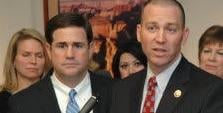A federal review of 65 Arizona neglect and abuse cases shows the state has made some gains in recent years, but still falls short in six of seven recommended outcomes for children and their families.
Children involved in the Department of Child Safety cases reviewed were receiving the right services for their educational needs, the report shows. But the state was not found to be “strong” in ensuring other positive outcomes for children: protecting them from abuse and neglect, ensuring safety at home, creating stable living situations, providing adequate services for their physical and mental-health needs and maintaining family connections and relationships. The final area that was not recorded as a strength pertains to children’s families receiving the services they need.
“There’s nothing that’s a surprise to me in this report at all,” said Katherine Guffey, the agency’s chief quality-improvement officer. “The concerns that are expressed here are concerns we had already.”
Guffey said the evaluation is intended to help the system continue to make improvements. No state has ever passed all the criteria, she said.
“If you passed, you’re perfect,” she said, “and nobody has been perfect yet.”
Areas where the state scored well include staff training, training for foster and adoptive parents, diligent recruitment of foster and adoptive homes, assessing needs, and services provided to prevent removals or re-entry into foster care.
For a state to be in “substantial conformity” with most outcomes, 90 percent or more of the cases reviewed must have achieved that outcome. However, 95 percent or more of the cases had to be in compliance for the state to do well in the categories of protecting children from abuse and neglect, and in children having permanency and stability in living situations.
Guffey said some things pointed out in the report are areas the agency was already focusing on, including improving on case planning as well as services and engagement with parents, and shrinking waiting lists for services.
“One of the important things about this report is that it validates and supports the direction we are going,” she said.
Failure to comply with the recommendation could impact federal funding the DCS receives.
Beth Rosenberg, director of child welfare and juvenile-justice policy with the Children’s Action Alliance, said no matter how well or poorly Arizona does on an assessment like this, “It can’t be overlooked that we have a growing number of children in state custody.”
“We’re not filling in the holes that need to be filled in,” she said. “When we bring kids into foster care, they are not stable. They are being moved from placement to placement.”
The finding that children in state custody were having their educational needs met was a surprise to Pete Hershberger, a former state legislator who runs FosterEd, a foster youth program based in Pima County.
“We know that these students are in a distinct subgroup,” he said. “There’s a dramatic problem with students in foster care, and yet this report says it’s a strength.”
His organization and the Arizona Community Foundation were behind a recent study that shows a staggering “invisible achievement gap” with foster children, who have the state’s highest dropout rate and among the lowest graduation rates.
Forty percent of these children and teens changed schools during the 2012-13 school year — and one in seven attended three or more schools that year, the report found. Their academic performance trails that of every other type of student — even those facing significant risk factors such as poverty, limited English-language proficiency and a variety of disabilities.
Hershberger said he doesn’t mean to “pile on” already overworked caseworkers, but instead says it was inevitable there would be struggles, considering all the cuts to services in recent years.
“With the cuts that this agency has had, and with the accompanying cuts in our safety net, we are in a downward spiral,” he said.
This is the third time the U.S. Department of Health and Human Services’ Children’s Bureau has assessed Arizona’s child welfare system — the others were in 2001 and in 2008, when DCS was called Child Protective Services.
The cases reviewed this time were from Maricopa, Pinal and Yuma counties from April 2014 through January 2015, including 40 cases of children in foster care and 25 of children still living at home.
The report notes that there have been substantial changes to the process, which make it not directly comparable to Arizona’s two previous assessments.





